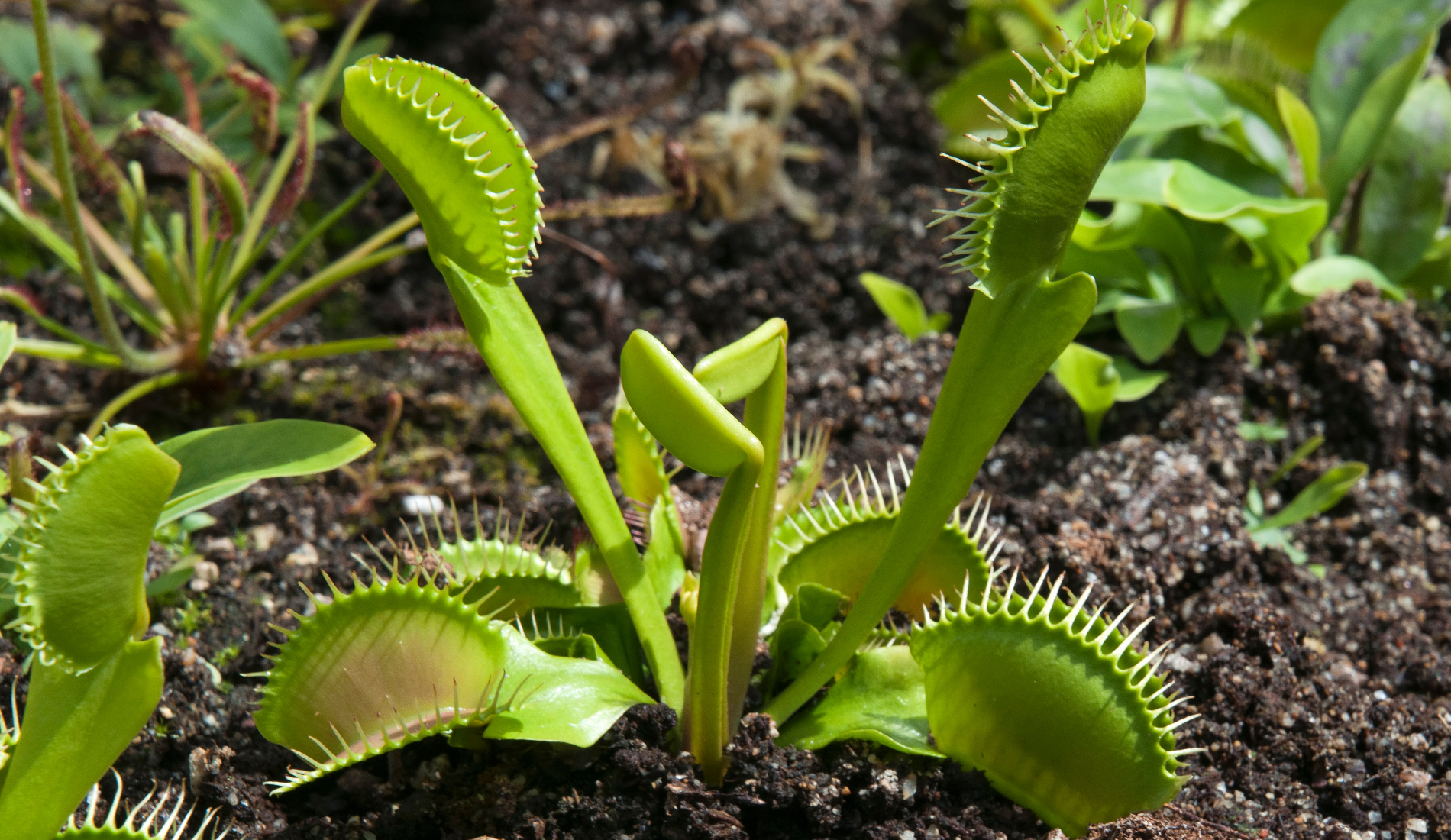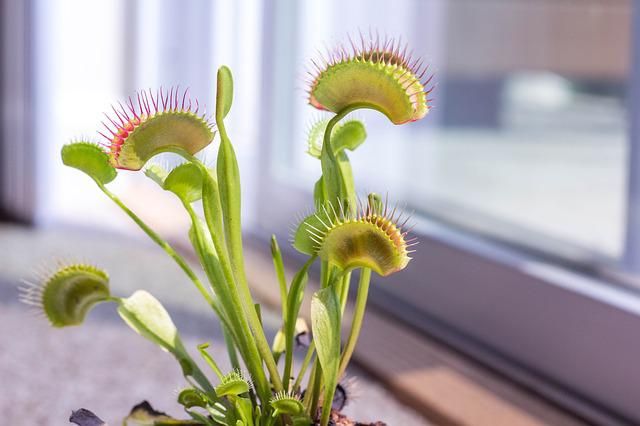Venus fly traps are easily the most recognizable carnivorous plant. Their traps contain multiple trigger hairs which stimulate the trap to close when set off by insect movement. It only takes an insect tapping the same hair twice within a few seconds, or tapping two hairs simultaneously to trigger the trap to close. At that point, the Venus fly trap will release digestive enzymes enabling it to absorb the nutrients inside its insect prey! Pretty cool!
Venus fly traps are native to the eastern regions of North and South Carolina exclusively. Unfortunately, wild collection of these plants still takes place, threatening the survival of this plant species. It is best to source your venus fly traps from propagation via tissue culture.
These plants typically only grow about an inch or two tall and wide. They do best outdoors, but can be grown inside as well. The key is to create an environment reminiscent of their natural habitat using this step-by-step guide:
Materials Needed
- Sunny space
- Plastic, styrofoam, or glazed ceramic draining pot
- 1:1 peat moss and perlite growing medium
- Distilled, reverse osmosis or rainwater (NO TAP WATER)
- Terrarium tweezers
- Insect prey
A Step-By-Step Guide for Growing and Caring for Venus Fly Trap
Step One: Find the Right Environment
Image credits: CorrieMiracle via Pixabay
Venus fly traps grow best outdoors with four hours of direct sunlight followed by two to four hours of bright, indirect sunlight. They can also be grown indoors, either on a south facing sunny window sill, or under a grow light for ten to twelve hours per day. If you are using a grow light, you will require a light system with blue wavelengths, located about six to eight inches above the tip of your Venus fly trap. Regardless of the home you choose, remember that these carnivorous plants need humid environments for the duration of their growing period.
Step Two: Aquire Materials to Repot
You are going to want to repot your Venus fly trap into a well-draining plastic, styrofoam, or glazed ceramic pot. Repot your plant annually to provide adequate growth room and keep the potting medium from becoming too compacted at its roots. Venus fly traps contain rhizomes; a white, bulbous root stalk that will produce the shoots and root systems of a new plant, while helping to store energy. These roots require a pot depth of at least 4 inches for optimal growth. Leaving about 2 inches of potting medium around the rhizomes will enable a buffer of insulation to protect from extreme heat or cold.
The best ratio for your growing medium is a one-to-one ratio of peat moss and perlite. Alternatively, you can use high-quality, fiber sphagnum moss. You do not want to use regular potting soil for these carnivores, as it is not conducive to the nutrient-deficient soil found in their native bogs.
Step Three: Repot
Image credits: jamesvaughan via Pixabay
Once you have acquired your soil mixture, fill your pot and gently moisten with distilled, reverse osmosis, or rainwater. Do not use tap water as it contains too many minerals, and may be too alkaline for your Venus fly trap to handle.
Create a hole in the center of your pot, where your Venus fly trap will sit.
Carefully remove your plant from its original container by handling the root ball, not the traps. You don't want to waste any of its precious energy by accidentally trigging a trap! Gently remove the soil around its roots and plant in your moist, potting mixture. Pat the soil around the roots to hold your plant in place, but not so much that the soil is heavily compacted and a risk to root growth.
Water your plant thoroughly after repotting so that the water drains through the bottom of your pot. You may notice a stall in growth for about one to two weeks after repotting. This is normal! Repotting annually helps to keep the roots fresh, and your plant flourishing.
Step Four: Keep Moist
Every few days it is best to let the base of your plant's pot sit in a saucer of water for a few hours. You want the soil to remain moist, but the roots should never be submerged in water.
If you are growing your plant outdoors, make sure to give it some cool water on those super hot summer days. This will prevent your roots from over-heating and root rot from forming.
Remember: do not use tap water; only distilled, reverse osmosis or rainwater will do for these particular plants!
Step Five: Feed Your Plant
Image credits: Dugeot via Pixabay
Due to the fact that venus fly traps grow wild in the nutrient-deficient soil of bogs, they've adapted to source their food from insect prey. This means that you do not want to add any fertilizer to your soil; your plant doesn't need it!
A Venus fly trap planted outside will catch prey all on its own. When growing indoors it is best to collect live flies, beetles, crickets, or spiders to feed your plant. Using terrarium tweezers, gently place your squirming insect inside one of the traps. Watch as the plant closes around its prey and slowly digests the nutrients within! You only need to feed them one to two insects per month.
Step Six: Crucial Winter Dormancy Period
In autumn, you will begin to notice some changes. This is because the plant is beginning to go through its crucial winter dormancy period. The first signs you will notice are it will stop growing and the leaves will begin to turn black and die. The traps on your plant will cease to trigger, and it is imperative not to feed your plant any insects while it goes through this three to four month period. Don't worry, it isn't dead! This period is necessary whether your plant is growing indoors or out, and only requires different care.
When the signs of winter dormancy start to hit, transfer your plant into a cool location such as a basement or garage. During this time, they don't require much light but having a window nearby is a good idea. In the wild, these plants can survive temperatures as low as 20 degrees Fahrenheit. However, keeping your plant between 35 and 50 degrees during winter dormancy is ideal. You may leave your venus fly trap outdoors if you live in an area where the temperature will not drop below 30 degrees.
Keep your plant moist during these months, but otherwise don't fuss around with it too much. You may move your venus fly trap back to its original home come springtime when temperatures rise above 50 degrees. If any dead leaves remain, now is the proper time to cut them off.
To Sum it Up:
Image credits: MonikaP via Pixabay
Grow your venus fly trap in a sunny, humid environment. Make sure to have a well-draining pot, with the correct potting medium. Always use distilled, reverse osmosis or rainwater; no tap water! Keep your plant moist, and well-fed throughout the growing period. Remember to mind the crucial winter dormancy period, and adhere to its specific care procedures. By following this guide, you will successfully know how to grow and care for your very own carnivorous, venus fly trap!


